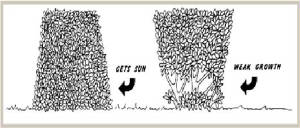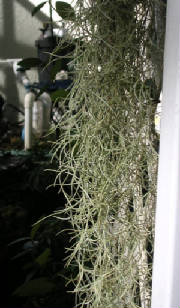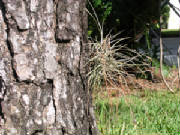We didn't have much in the way of cold weather and the unusual amount of rain has been beneficial to our landscapes
and the aquifer. However, water will continue to be an issue in Florida and we need to be cautious of our use of it in the
landscape. Pruning:
If you have shrubs or hedges that
have grown too tall or large for the space they

are in, now is the time for some drastic pruning to bring them down to size. Viburnum and Ligustrum
can be pruned back by 1/3 to ½ now. This is also true for dwarf Yaupon hollies. This is a good time to shape any
plants that have become leggy. Remember, Crape Myrtles do not require the drastic pruning that we so often see. They will
bloom quite well with just a light pruning to remove crossing or rubbing branches and dead twigs in the interior of the plant.
In fact, it is the drastic pruning that encourages many sprouts at the base of these trees. These sprouts should always be
removed.
There are a number of plant diseases that can be spread by pruning tools.
It is best to disinfect your pruning tools after each use by dipping the cutting surfaces in a solution of one part bleach
to nine parts water or rubbing alcohol (70%) from the drug store (does not require diluting). If you have a lawn service
that does your pruning, ask that they disinfect their tools prior to using them in your yard. true
for dwarf Yaupon hollies. This is a good time to shape any plants that have become leggy. Remember, Crape Myrtles do not
require the drastic pruning that we so often see. They will bloom quite well with just a light pruning to remove crossing
or rubbing branches and dead twigs in the interior of the plant. In fact, it is the drastic pruning that encourages many
sprouts at the base of these trees. These sprouts should always be removed.
Fertilizing:
University of Florida research on nutrient needs of lawns in Florida (You Tube http://www.youtube.com/watch?v=-Q5QOL_WU1Q)
suggests that you should not apply fertilizer to lawns before April and no later than early October. So I am now recommending
that you fertilize your lawns in April. Shrubs, palms and other ornamental plants can be fertilized now with a 100% slow
release formula of 8-0-12 that also contains minor nutrients. Palms especially need this type of fertilizer to ward off nutrient
deficiencies. Well established ornamental shrubs really only need this March fertilization each year. However, palms do
need fertilization three times per year, March, late May and October.
Vegetables:
If you are planning to grow some veggies this spring, those that can be planted now include: beans, corn, cucumbers,
eggplant, peppers, summer squash, tomatoes and watermelon. Those of us living near conservation areas or Brooker Creek Preserve
have a real problem with critters eating veggies. You can grow some veggies quite successfully inside a screened enclosure
if there is full sun. Veggies like cucumbers and squash that need a pollinator to move pollen from male to female flowers
do not work inside the screen unless you want to become the pollinator with a small artists paint brush. For more information
on growing vegetables, go to: http://edis.ifas.ufl.edu/pdffiles/VH/VH02100.pdf
Other chores:
Don't be tempted to scalp the lawn to remove the grass that has
turned brown. You can damage the lawn by removing living growing points that are protected by the brown grass blades. Those
brown blades will decay back into the soil.
Give your winter annuals, such as snapdragons, petunias,
pansies or geraniums, a light pruning and balanced slow release fertilizer. You should see a new flush of bloom that lasts
into May. This is also a good time to divide perennials and do any transplanting of shrubs or flowers that you want to move
to a different location. Remember to provide plenty of water for several weeks after transplanting.
Add
a fresh layer of organic mulch once all spring clean-up has been completed. Be careful to keep the mulch a couple of inches
away from the base of plants and not more than two to three inches deep. You do not need to remove old mulch, just add the
fresh mulch to the top. The old mulch will continue to decay and add needed nutrients to the soil.
Be
on the lookout for aphids, mealybugs and whiteflies. They are attracted to the succulent new growth on plants in the spring.
A good shot of water from the hose will knock aphids off, or try Neem oil. Neem is a least toxic alternative to chemical
pesticides. Spray in the evening when bees are less active. Also, see if there are beneficial insects like ladybugs and
green lacewings already feeding on them. They could be doing the job for you.
A number of people continue to ask me this question - "Is Spanish moss or ball moss killing my tree"?
In short, the answer is no. Spanish moss and ball moss are two of Florida's 16 native bromeliad species. Both are epiphytes,
or air plants, that are actually related to pineapple plants. Epiphytes attach root structures to
their host plant, but, they do not parasitize or take nutrients from this plant; they simply use it for support. Air plants,
like most plants, make their own food through photosynthesis. If air plants become so thick that they shade the leaves of
the tree, growth could be slowed down. You usually see more of these plants on weakened or damaged trees or shrubs because
they also have thinner foliage. The thinning foliage allows more light into the branches, thus stimulating the growth of
the air plants. So, air plants grow faster on stressed trees because the trees are weakened, but do not cause the poor tree
growth.

Spanish Moss (Tillandsia usneoides) is found hanging in streamers, usually from tree limbs,
especially live oak and cypress. However, it can grow on most any support including shrubs, fences and trellises. It is gray
when dry and light green when wet. It can hang down from tree branches in streamers up to 20 feet long. The small flowers
are pale green or blue and are fragrant at night. Stems and leaves are slender and curly. Spanish moss has no roots; the
leaves catch water and nutrients from moisture and dust in the air.

Ball Moss (Tillandsia recurvata) is gray-green and found on tree branches or telephone
wires. It is often mistaken for a small clump of Spanish moss. It grows in clumps 6-10" in diameter on most kinds of
trees and other supports. The blue to violet flowers are carried on a long central stem where a one inch long seed pod soon
develops. The tiny seeds are blown by the wind until they land on a tree branch where they stick fast and develop root-like
attachments to the outside of the bark.
Ball moss is able to convert nitrogen in air into a form
that plants can use like fertilizer. Except for beans and peas, most plants cannot do this. So, when ball moss falls to the
ground and decomposes, it provides a little more fertilizer for other plants.
You might
see one or more of the other Florida native bromeliads in trees in your landscape, especially if you live very near Brooker
Creek Preserve or the other conservation areas here in the Woodlands. I have a nice specimen of one living in a bottle brush
tree beside my garage that I really like. I have included a picture; it looks more like a pineapple plant than either ball
moss or Spanish moss. Ten of Florida's 16 native bromeliad species are considered threatened or endangered. Increased development
causing a loss of habitat, the collection of specimens from natural areas, and infestation with the non-native Mexican bromeliad
weevil (Metamasis callizona) constitute the greatest threats to these natives. You might notice dead bromeliads on the ground
if you are hiking in preserve areas. These have most likely died due to the Mexican bromeliad weevil.
For more information about all of Florida's native bromeliads including Spanish and Ball mosses, please access the
UF/IFAS Extension publication Florida's Native Bromeliads at: http://edis.ifas.ufl.edu/pdffiles/UW/UW20500.pdf

